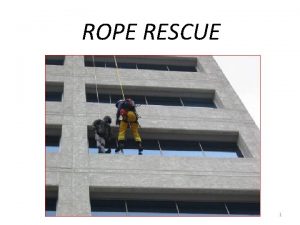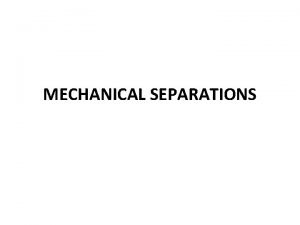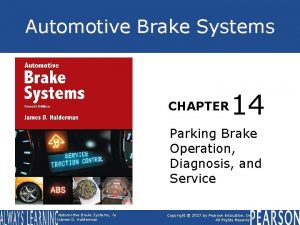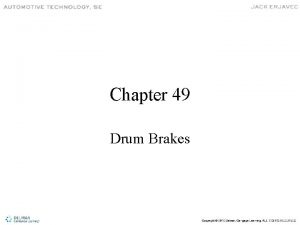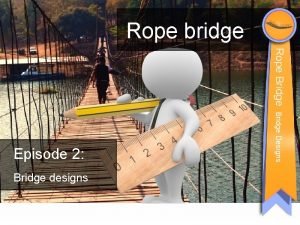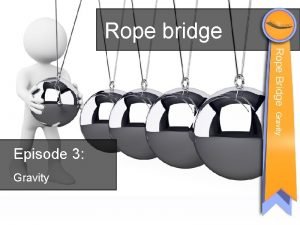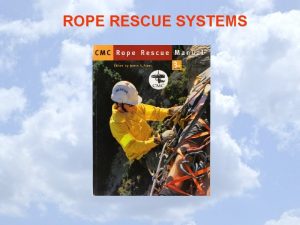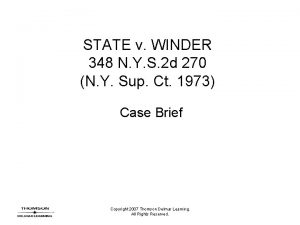Drum winders Rope safety factors and winder rope






















- Slides: 22

Drum winders: Rope safety factors, and winder rope deterioration by Mike van Zyl

Two topics will be discussed today: The safety factors (regulations) for drum winder ropes. A unique deterioration mechanism of drum winder ropes, and which ropes are the most suitable for drum winders.

The “old regulations” came into existence in the 1950’sand remained in force until the mid 1090’s. Most of the drum winders that are still in operation now in South Africa would have been designed around these regulations. Rope discard: A winding rope shall not be used if the breaking force at any point is less than nine-tenths of the initial breaking force. Conveying persons or material: The greater of: Capacity factor = 10 Safety factor = 5 at discard Conveying of mineral (rock or ore): The greater of: Capacity factor = 9 Safety factor = 4, 5 at discard Typically, the ropes of a shallow man winder would have been selected to give a capacity factor of 11 so that after an estimated 10% reduction in strength (deterioration such as broken wires) the capacity factor would still be around 10. The ropes of a deep rock winder would have been selected to give a safety factor of 5 at installation so that after 10% deterioration, the safety factor would be 4, 5 at discard.

The current regulations (from the mid 90’s) are: Rope discard: The condition of a winding rope must be assessed in accordance with the SABS Code of Practice for the Condition Assessment of Steel Wire Ropes on Mine Winders, SABS 0293 as amended and the rope may not be used if the condition thus assessed at that point in the rope has reached the discard criteria. Conveying persons, or material, or mineral: The greater of: Capacity factor Safety factor = 8 = 4, 5 at installation The discard criteria of the SABS code of practice are based on an approximate 10% reduction in strength. The required capacity and safety factors “at installation” are calculated on the new rope breaking strength. So if you started off at a capacity factor of say 8, 11 then the actual capacity factor when the rope reaches discard will be 7, 3. That the latter is less than 8 is of no concern anymore: The new rope will have a specified minimum strength, and the rope will be discarded when the discard criteria are reached.

Rope safety is governed by two parameters: The rope loads and the remaining strength of the rope. Rope loads are covered adequately by the prescribed rope safety factors. The remaining strength of a rope is determined (mostly) by magnetic testing of the ropes. The deterioration mechanisms of a rope on a drum winder should be predictable (i. e. known), should be acceptable, and the deterioration of the rope should be gradual. The installation will then remain in an acceptable condition until that is confirmed by the next rope inspection.

I will explain the behaviour of triangular strand ropes operating on drum winders and in vertical shafts. Through this exercise you should be able to appreciate the specific behaviour of these ropes. By comparing the characteristics of other types of rope constructions to that of triangular strand ropes, you will be able to see why they behave differently and why some rope constructions simply do not work on drum winders, especially when you have three and more layers of rope on a drum. Triangular strand ropes that operate on drum winders generally and eventually develop “severe” plastic deformation of the outer wires of the strands that are on the outside of the rope.

Plastic deformation of a triangular strand rope that operated on a drum winder Severe plastic deformation can lead to split wires, and possibly secondary bending fatigue. Virtually no metal is lost.

What is the cause of the plastic deformation? To be able to predict how a rope will behave on a drum winder, you have to understand the torque-tension characteristics of a rope.

Torque-tension graph of a 42 mm diameter triangular strand rope loaded in tension

Torque-tension-twist graphs for a 42 mm diameter triangular strand rope

So how will the rope behave in the shaft?

Know you know how a triangular strand rope will behave in a shaft. What will happen when the front end of the rope is released from the conveyance? How will a rope that is totally non-spin behave? What happens on the dead turns of a rock winder after off-loading? Why do you have to do double-downs and back-ends on a drum winder?

Abrasive wear lines on the dead turns

Abrasive wear groove on the dead turns

Before doubling-down

After doubling-down

By now you have realised that it is good to have a rope that develops torque when loaded in tension. You have now also realised why you cannot just forget about the dead turns on the drum. And for the final part of my presentation, I will introduce a new theory to add to the deterioration mechanisms of drum winder ropes. I will call it The cylindrical shape rope deterioration theory I cannot prove theory yet (i. e. mathematically). The theory originated from observing the plastic deformation of ropes operating on drum winders.

Cross-section of a triangular strand rope

The cylindrical shape rope deterioration theory

Plastically deformed outer wires from a triangular strand rope

A rope with compacted outer strands

How would this rope deform?
 Rhonda scheffler and kippi vaught
Rhonda scheffler and kippi vaught Danielle winder
Danielle winder A rope is wrapped many times around a drum of radius 50 cm
A rope is wrapped many times around a drum of radius 50 cm Drum buffer rope
Drum buffer rope General safety rope
General safety rope Macbeth seyton i am sick at heart
Macbeth seyton i am sick at heart Stirred tank bioreactor disadvantages
Stirred tank bioreactor disadvantages Hp 7550 pen plotter
Hp 7550 pen plotter Are flowers biotic or abiotic
Are flowers biotic or abiotic Abiotic vs biotic factors
Abiotic vs biotic factors Aboitic environment
Aboitic environment Greatest common factor of monomials
Greatest common factor of monomials 7-1 factors and greatest common factors
7-1 factors and greatest common factors Gcf of 56 and 42
Gcf of 56 and 42 Jst umn
Jst umn The drum john scott
The drum john scott Musical instrument in mindanao
Musical instrument in mindanao Leaf filter advantages and disadvantages
Leaf filter advantages and disadvantages Atavism poem
Atavism poem Non servo drum brakes
Non servo drum brakes Ball and ramp parking brake
Ball and ramp parking brake Rohacell hero
Rohacell hero Korean music traditionally associated with the lower class
Korean music traditionally associated with the lower class




